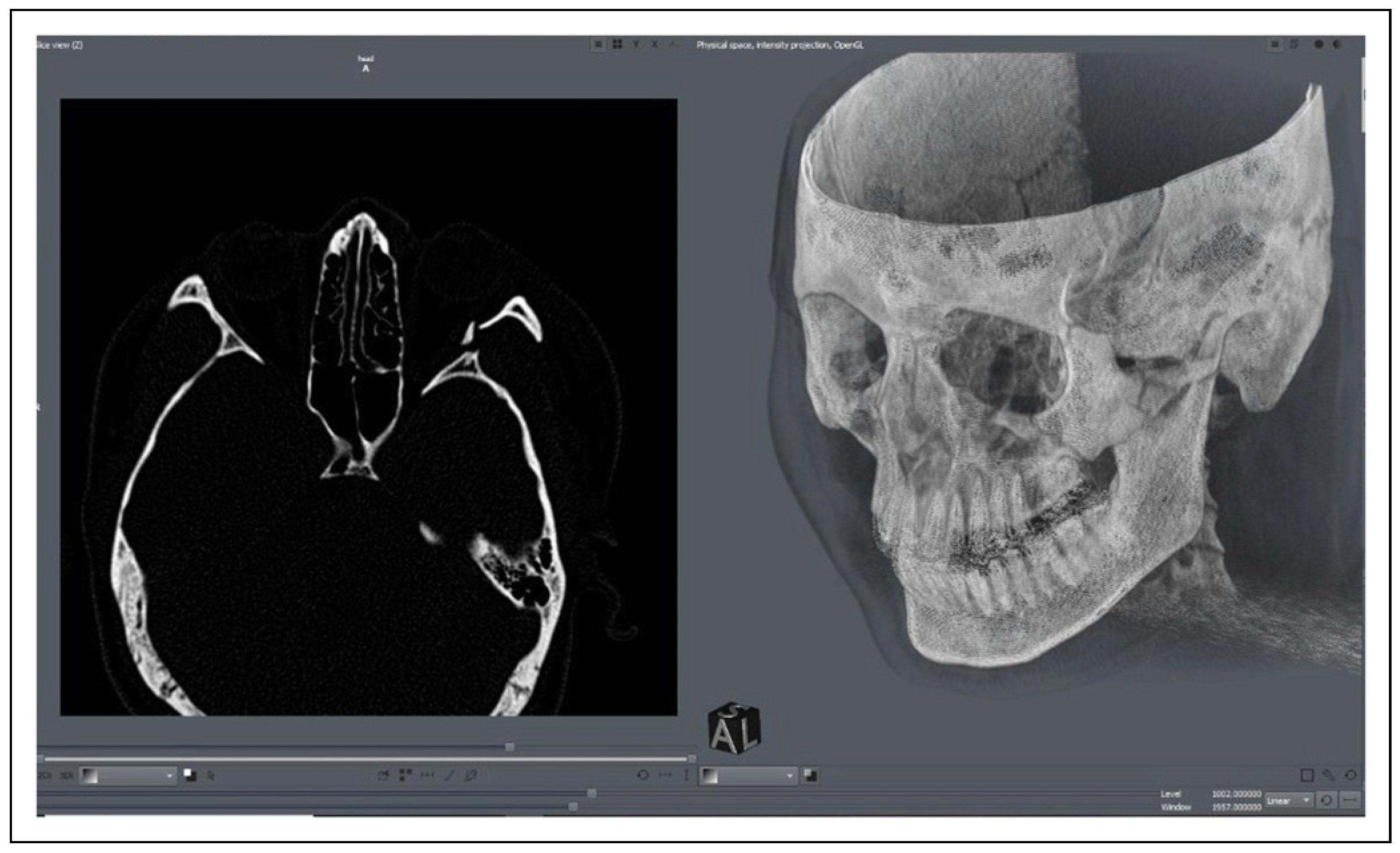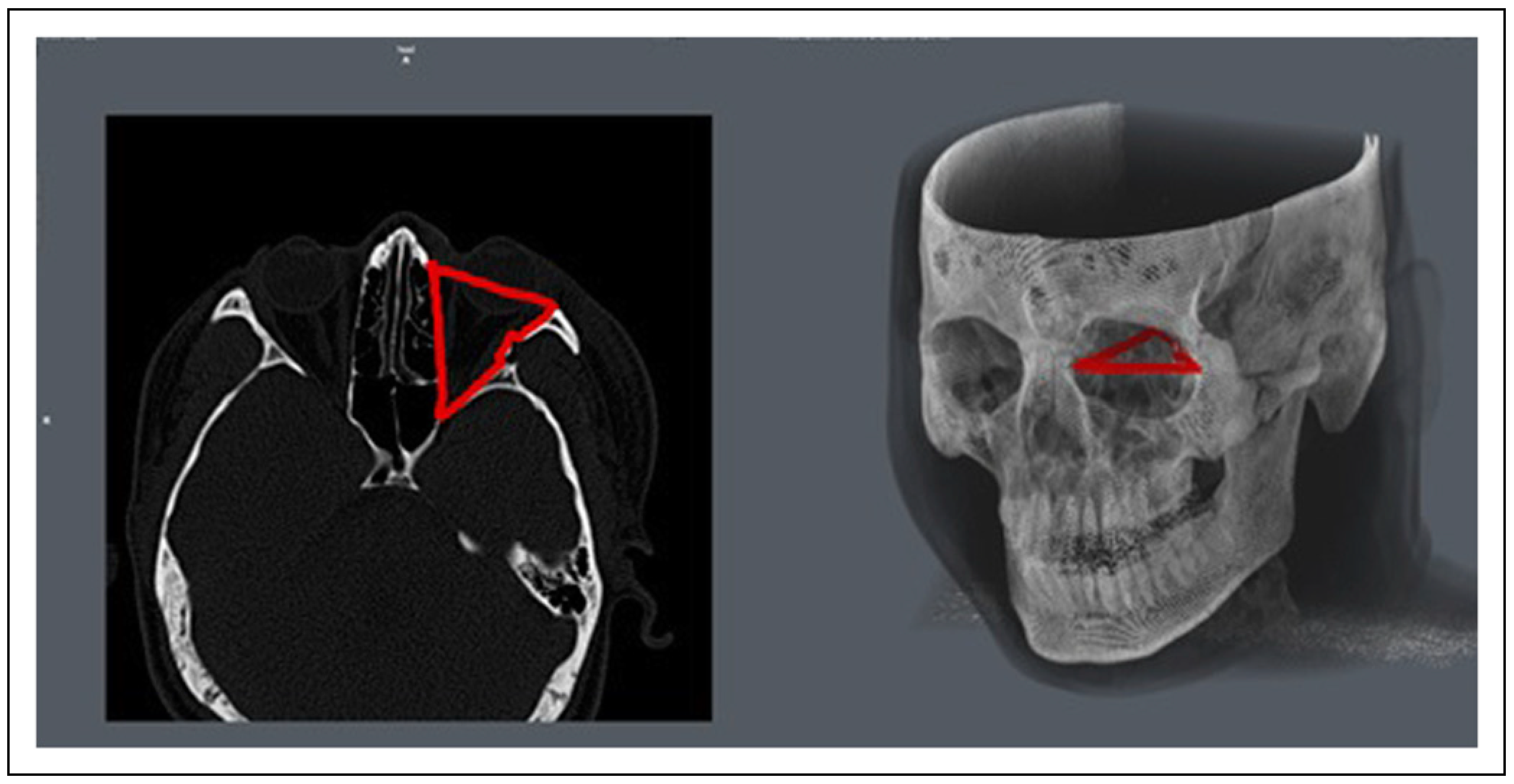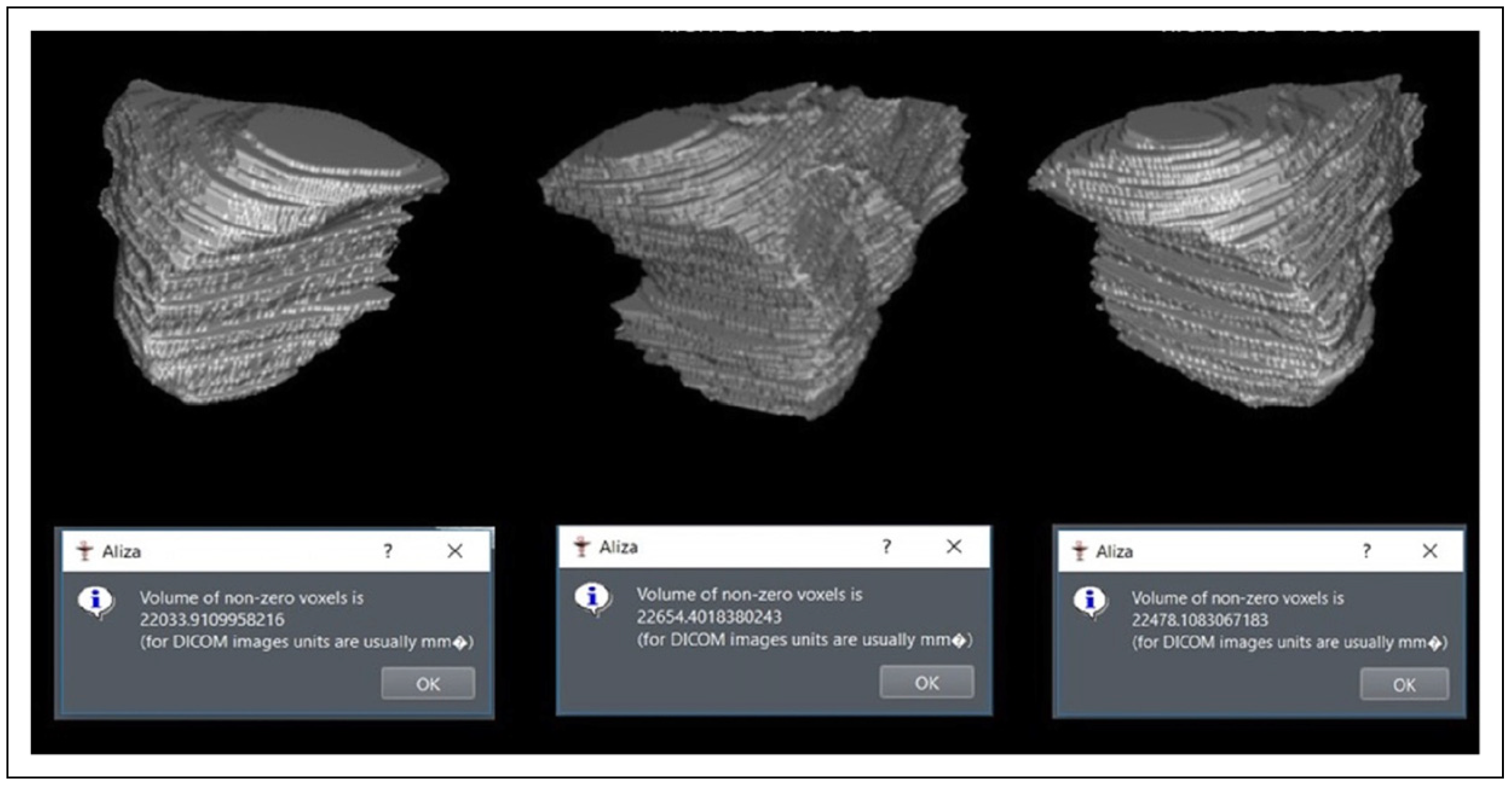Measuring Orbital Volume Using Open Source Software and Its Application in Orbitozygomatic Fractures
Abstract
:Introduction
Technical Note
- The DICOM images of the CT scans were loaded into the software.
- The interface screen displayed the cross-section of each slice in a 2D format on the left and the 3D rendering of the patient on the right. (Figure 1).
- In each axial section image, the margins of the orbit were manually selected by using the “Draw” option of the Region of Interest (ROI) tool. (Figure 2) For volume calculation of each orbit, the marking on every axial section was added to the same ROI. The anterior boundary was determined by a line joining the medial and lateral orbital rims. The posterior boundary was defined by the initiation of the optic foramen, inferior and superior orbital fissure [4].
- After completion of manual segmentation of the concerned orbit, the ROI is selected and converted to a binary image. The volume was computed automatically by the software in mm3 (Figure 3) and then converted to cubic centimeters.
Discussion
Conclusions
Funding
Declaration of Conflicting Interests
References
- Ploder, O.; Klug, C.; Voracek, M.; et al. Evaluation of computer-based area and volume measurement from coronal computed tomography scans in isolated blowout fractures of the orbital floor. J Oral Maxillofac Surg 2002, 60, 1267–1272. Available online: https://pubmed.ncbi.nlm.nih.gov/12420258/ (accessed on 30 April 2021). [PubMed]
- Fan, X.; Li, J.; Zhu, J.; et al. Computer-assisted orbital volume measurement in the surgical correction of late enophthalmos caused by blowout fractures [Internet]. Ophthalmic Plast Reconstr Surg 2003, 19, 207–211. Available online: https://pubmed.ncbi.nlm.nih.gov/12918556/ (accessed on 30 April 2021). [PubMed]
- Ellis, E.; Reddy, L. Status of the Internal Orbit after Reduction of Zygomaticomaxillary Complex Fractures. J Oral Maxillofac Surg 2004, 62, 275–283. Available online: https://pubmed.ncbi.nlm.nih.gov/15015156/ (accessed on 30 April 2021). [PubMed]
- Jansen, J.; Schreurs, R.; Dubois, L.; et al. Orbital volume analysis: validation of a semi-automatic software segmentation method. Int. J. Comput. Assist. Radiol. Surg. 2016, 11, 11–18. [Google Scholar] [CrossRef] [PubMed]
- Osaki, T.H.; de Castro, D.K.; Yabumoto, C.; Mingkwansook, V.; Ting, E.; Nallasamy, N.; Curtin, H.; Fay, A. Comparison of Methodologies in Volumetric Orbitometry. Ophthalmic Plast Reconstr Surg. 2013, 29, 431–436. [Google Scholar] [CrossRef] [PubMed]
- Zhang, X.; Han, C.Y.; Dai, M.J.; et al. Application of computer-assisted surgery techniques in the management of zygomatic complex fractures. Chinese Journal of Traumatology—English Edition 2018, 21, 281–286. [Google Scholar]
- Sharma, R.; Muralidharan, C.G.; Roy, I.D.; et al. Radiological evaluation of sphenozygomatic suture fixation for restoration of orbital volume: A retrospective study. J Cranio-MaxilloFac Surg 2016, 44, 1903–1908. [Google Scholar] [CrossRef] [PubMed]
- Charteris, D.G.; Chan, C.H.; Whitehouse, R.W.; et al. Orbital volume measurement in the management of pure blowout fractures of the orbital floor. Br J Ophthalmol 1993, 77, 100–102. [Google Scholar] [PubMed]
- Regensburg, N.I.; Kok, P.H.B.; Zonneveld, F.W.; et al. A new and validated CT-based method for the calculation of orbital soft tissue volumes. Invest Ophthalmol Vis Sci 2008, 49, 1758–1762. [Google Scholar] [PubMed]
- Ebrahimi, A.; Kalantar Motamedi, M.H.; Rasouli, H.R.; et al. Enophthalmos and Orbital Volume Changes in Zygomaticomaxillary Complex Fractures: Is There a Correlation Between Them? J Oral Maxillofac Surg 2019, 77, 134.e1. [Google Scholar] [CrossRef] [PubMed]



 |
© 2008 by the author. The Author(s) 2008.
Share and Cite
Narayan, T.P.V.; Dhupar, V. Measuring Orbital Volume Using Open Source Software and Its Application in Orbitozygomatic Fractures. Craniomaxillofac. Trauma Reconstr. 2024, 17, 169-172. https://doi.org/10.1177/19433875231163982
Narayan TPV, Dhupar V. Measuring Orbital Volume Using Open Source Software and Its Application in Orbitozygomatic Fractures. Craniomaxillofacial Trauma & Reconstruction. 2024; 17(2):169-172. https://doi.org/10.1177/19433875231163982
Chicago/Turabian StyleNarayan, Taradevi P. V., and Vikas Dhupar. 2024. "Measuring Orbital Volume Using Open Source Software and Its Application in Orbitozygomatic Fractures" Craniomaxillofacial Trauma & Reconstruction 17, no. 2: 169-172. https://doi.org/10.1177/19433875231163982
APA StyleNarayan, T. P. V., & Dhupar, V. (2024). Measuring Orbital Volume Using Open Source Software and Its Application in Orbitozygomatic Fractures. Craniomaxillofacial Trauma & Reconstruction, 17(2), 169-172. https://doi.org/10.1177/19433875231163982




